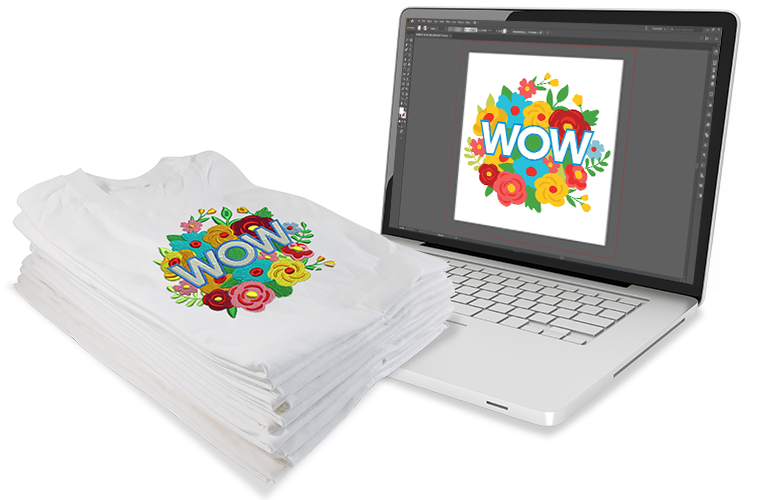Simplifying the Art of Needlework Digitizing: Step-by-Step Guide
Embroidery digitizing is a thorough craft that requires precision and creativity. As innovation remains to advancement, the digitization process has actually become more available, allowing enthusiasts to bring their detailed layouts to life easily. In this overview, we will certainly untangle the complexities of needlework digitizing, damaging down each step methodically to enhance the process and empower both novices and experienced embroiderers alike. Keep tuned to find exactly how you can simplify this detailed art form and transform your imaginative visions right into perfectly stitched work of arts.
Understanding Needlework Digitizing Software Application
Embroidery digitizing software offers as an important tool for changing elaborate layouts right into digital layouts compatible with needlework equipments, facilitating precise sewing and personalization. This specific software application allows customers to import various photo documents styles, such as JPG or PNG, and convert them into embroidery machine-readable formats like DST, EXP, or PES - Digitizing for Embroidery. By utilizing features like stitch editing and enhancing, padding alternatives, and string color option, digitizing software allows users to manage every facet of the style process
Moreover, progressed needlework digitizing software program supplies devices for producing intricate designs, readjusting stitch density, and including complex details. Users can likewise sneak peek the layout before sewing it out, making certain accuracy and lessening mistakes. In addition, lots of software application provide automated features that aid simplify the digitizing procedure, saving time and effort.
Recognizing the capabilities of embroidery digitizing software application is essential for attaining top quality cause needlework tasks. By mastering this device, embroidery fanatics and specialists can unleash their creative thinking and bring detailed styles to life with accuracy and performance.

Choosing the Right Style Data
After familiarizing on your own with the capabilities of needlework digitizing software program, the next vital action in the process is selecting the appropriate style file for your task. Digitizing for Embroidery. When selecting a design declare embroidery digitizing, it's important to consider the intricacy of the design, the size of the end product, and the sort of textile you will be dealing with
For complex layouts with great information, a high-resolution photo or vector file is suggested to make certain that the embroidery device can precisely recreate the layout. Furthermore, the size of the last product plays a significant role in selecting the right layout documents. Larger styles may require higher resolution files to preserve clarity and sharpness.
Furthermore, the kind of material you will be embroidering on influences the selection of design file. Different materials may require modifications in the layout data to make sure that the stitches are properly lined up and the design appears as intended. By meticulously picking the appropriate layout documents based upon these aspects, you can set yourself up for an effective embroidery digitizing process.
Digitizing Tools and Strategies
Utilizing specialized software and precision methods, digitizing tools are essential in transforming complex layouts right into embroidery-ready files. Embroidery digitizing software application, such as Wilcom, Hatch, or Embrilliance, provides the required system to transform artwork right into stitch data. These programs provide attributes like stitch modifying, padding choices, and lettering tools to guarantee the layout equates effortlessly browse around this web-site onto material.
One of the crucial strategies in digitizing is producing a clear path for the needlework machine to comply with. This entails digitizing each component of the style with accuracy, determining stitch types, densities, and instructions. By utilizing devices like digitizing tablets or software-specific plugins, embroiderers can achieve a high level of accuracy in their digitized designs.
In addition, understanding the art of underlay stitching is crucial for generating top quality needlework. Underlay sewing stabilizes the material and creates a investigate this site structure for the layout, making certain that the final item is both visually attractive and resilient. By comprehending these digitizing devices and strategies, embroiderers can boost their craft and bring intricate styles to life with accuracy and effectiveness.
Tailoring Stitch Types and Instructions
Having actually developed a foundation in digitizing tools and methods, a critical facet beforehand needlework workmanship depends on tailoring stitch types and directions with accuracy and objective. The selection of stitch types can dramatically impact the overall appearance and appearance of the stitched design. Satin stitches, recognized for their smooth and glossy coating, work well for producing borders and text. On the various other hand, fill stitches are perfect for covering bigger areas successfully. By strategically integrating these stitch kinds, embroiderers can achieve depth and measurement in their layouts.
In addition, the direction of stitches plays an essential duty in improving the visual allure of the final needlework. By trying out with different stitch angles and patterns, embroiderers can bring their styles to life with exceptional information and intricacy.
Testing and Refining Your Digitized Style
To guarantee the accuracy and quality of your digitized design, complete screening and improvement are essential steps in the needlework digitizing process. When you have completed the digitization of your style, it is critical to evaluate it prior to proceeding with the actual embroidery. Checking permits you to recognize any possible issues such as string breaks, stitch density troubles, or layout distortions that may affect the outcome.

After screening, it is very important to refine your digitized design based on the responses from the examination sew-out. This may entail tweaking stitch setups, adjusting densities, or making adjustments to the general layout to attain the preferred outcome. By iterating via screening and refinement, you can fine-tune your digitized design to excellence before progressing with the real embroidery procedure.
Verdict
In final thought, mastering the art of embroidery digitizing calls for a thorough understanding of the software program, selecting the ideal layout documents, making use of digitizing tools and techniques, personalizing stitch kinds and directions, and screening and refining the digitized design. By adhering to these steps, embroiderers can streamline the digitizing procedure and produce high-grade stitched designs with accuracy and efficiency.
Comments on “Premier Digitizing for Embroidery: Perfect Stitch Each Time”